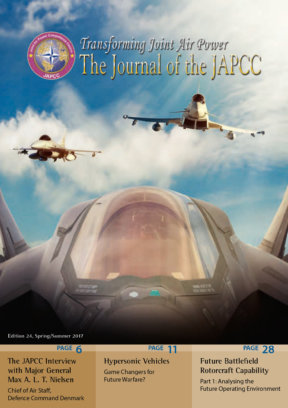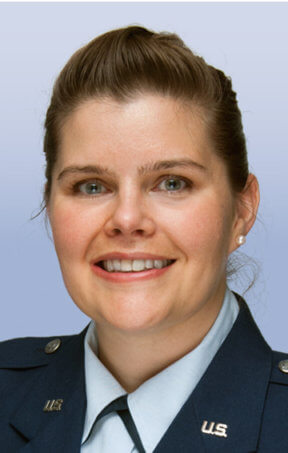‘Because we live in times with new security threats, with instability, and we don’t need more instability. We don’t need less cooperation in Europe; we need more.’
NATO Secretary General Jens Stoltenberg1
Introduction
In July 2016, NATO and the European Union (EU) leaders signed a Joint Declaration solidifying their commitment to greater collaboration and asserting information sharing, asset interoperability, and more integrated exercise and training programmes would help the two organizations address current and future threats.2 In December 2016 the respective Councils endorsed a common set of proposals on the implementation of the joint declaration, which underlined NATO and EU nations’ engagement to improve military capacity and capability building in concert to preserve their military vigour and cope with future challenges. In general terms, NATO and the EU address capacity with procurement and capability with interoperability programmes by preference through cooperation.
In the field of Air-to-Air Refuelling (AAR), European nations have ’formally begun the acquisition process for a new aerial refuelling capability under the [A330] Multinational Multi-Role Tanker Transport (MRTT) Fleet (MMF) project.3 Other procurement programmes for tanker aircraft including A400M are also underway. However, if NATO and the EU do not ensure tanker and receiver assets are interoperable, the capacity building investment will not be exploited to the fullest. Therefore, the first step in turning AAR capacities into capabilities is ensuring the tanker and receiver nations have issued a bilateral clearance to conduct refuelling. A bilateral clearance is granted when both nations have reviewed the technical and operational compatibility, crew training and currency, the level of maintenance ensured by the other nation, and made the appropriate legal and fiscal arrangements. In 2014, NATO adopted these issues as the Five Pillars of an AAR Clearance (see Figure 1).
In 2016, the Alliance furthermore issued the Guide to Obtaining AAR Clearances and Compatibility Certification. The guide is not mandatory but represents the only given NATO clearance process overview. Depending on the nation, the authority to permit an AAR activity via a clearance is delegated to different agencies. No matter who those agencies are, they should ensure that all pillars between a tanker and receiver pair have been addressed before granting a clearance.
While the Pillars easily present what should be reviewed in the clearance process, they do not explain how it should be accomplished. Until recently, no NATO or EU training existed to cover this subject. Therefore, the JAPCC developed the first-ever training and exercise event dedicated to the clearance process to continue increasing NATO and coalition interoperability in AAR operations.
The AAR Clearance/Approval Training and Exercise Concept
In January 2017, the JAPCC led a team of six agencies in conducting and hosting the first iteration of the ‘NATO and EU AAR Clearance Request/Approval Training and Table Top Exercise (TTE)’. Immediately after the JAPCC Executive Director approved the idea, the European Defence Agency (EDA) and the NATO International Staff – Defence Investment Division – (NATO IS/DI) agreed to support the effort within the frame of their ongoing activities on AAR. The Movement Coordination Centre Europe (MCCE) and the Dutch Flight Test Centre dedicated facilitators while the European Air Transport Command (EATC) offered to host the event.
The JAPCC-led team conducted nine months of planning prior to this first training event. Nothing like this had ever been done, and if the TTE missed the mark, it could have negatively affected global momentum in this critical area. The team decided on a three-day programme open to any EU or NATO entity with a tie to AAR. By casting the net wide, facilitators created an unprecedented opportunity for test personnel and government representatives to learn about and apply the clearance process alongside operators, industry, and planners. Eventually, the level of participation was beyond expectation with 74 personnel from 16 EU and/or NATO nations, 40 organizations, and two industry partners attending.
Problem Identification and Education
During the first two days of the event, facilitators from JAPCC, MCCE, and Dutch Test Centre brought all participants to the same level of understanding about the AAR clearance process by instructing and leading discussion on the NATO Defence Planning Process, the Five Pillars, and NATO-led operations that have highlighted the need for a TTE. Several lectures laid the fundamental knowledge about the AAR clearance request and verification processes including current NATO and national AAR directives and methods as well as the ones in development.
On Day 1, the Dutch Flight Test Centre hosted a seminar specifically designed for test and airworthiness personnel but open to subject matter experts representing any of the above mentioned Five Pillars. A Dutch test pilot facilitated discussion between military and industry personnel on challenges currently elongating AAR testing, one of which is the reluctance to share data. Therefore, since 2016, there has been a campaign supported by NATO IS/DI and EDA to create a data cross-recognition programme. This would allow nations to bypass costly technical data assessments and cumbersome sharing protocols by accepting the work of other test centres whose personnel have been specifically trained and certified at an agreed minimum standard. It would not only save human and financial resources but could ensure nations do not rely on something called a Category I, or ‘Urgent Need’ Clearance, which requires no testing and has the potential to put crews in a much riskier situation while refuelling. Attendees were supportive of the campaign and interested to get involved as NATO and the EU develop it further.
Leading into the training event’s exercise portion, the TTE participants were introduced to an on-going real world clearance dilemma. An AAR planner from MCCE explained that while over a dozen nations had committed tanker and/or receiver assets for the 2017 European Air Refuelling Training and ARCTIC CHALLENGE Exercise), many questions still remained about who would be able to refuel with whom. The presentation highlighted that failures in the clearance process are most recognizable during planning. Only at this stage is it evident which pillars of a clearance have not been addressed. This can lead to hasty Urgent Need Category I clearances or can result in mission cancellation – not an ideal scenario for commanders, planners, or operators.
TTE Scenarios, Lessons Identified, and Key Takeaways
In order to continue cross-pillar collaboration and build upon the first two days, TTE facilitators built ten clearance request scenarios. Students were assigned to teams of six varied by nationality and expertise and tasked with assessing whether or not a tanker and receiver pair in each scenario were capable of conducting AAR operations. The teams answered questions that specifically led them through the AAR process, NATO and national directives, and the JAPCC AAR matrix. Facilitators floated between teams to review solutions, discuss alternative outcomes, and assign the next scenario. Every team investigated at least three pairs. The scenarios enabled instruction on a standardized process, while allowing participants to experience known significant gaps of the AAR clearance process. The following lessons and key takeaways were particularly identified.
Simple mistakes. Several scenarios included requests for receivers to refuel with either technically or politically incompatible tankers. This ensured students learned the importance of knowing the capabilities of assets available and were particular about analysing requests and source documents. Simple mistakes due to lack of inventory knowledge or lack of AAR clearance verification experience in general, can have large repercussions such as nations committing assets that are not useable with other committed assets, or a complete scrap of an AAR plan.
Data sharing hurdles. As previously discussed, the cost of air refuelling asset data collection, over-classification of information, and commercial proprietary rules can be incompatible with national budgets and refuelling request timelines. Until the data cross-recognition programme is in place, nations use either their own data assessments or what is called a ‘read across’ in which Nation A’s previously collected data is verified, rather than collected again, by Nation B. A few scenarios led students through pairs that had no technical assessment completed, but because of the specific nations in the scenario, perhaps a read-across was possible.
Lacking document and terminology standards. Prior to 2013, the NATO doctrine covering AAR operations (ATP 3.3.4.2) contained national annexes which were populated with asset data, clearance information, contact information and operational specifics. Those annexes were removed from the ATP in favour of nationally maintained Standards Related Documents (SRD) which supplement the ATP. This concept allows nations to update their respective supplements without the requirement for ratification by all NATO nations. However, this decentralized control led to a lack of standardization in both document structure and terminology which increases the time needed to verify if a clearance exists or how to go about procuring one. To help solve this issue, the JAPCC created a national SRD template which has been posted to its website since early 2016, but only a few nations have adopted the layout. JAPCC is also conducting an informal study about the feasibility of implementing an online standardized SRD questionnaire for nations to populate themselves. The questionnaire could possibly also auto-populate the JAPCC AAR Compatibility and Clearance Matrix’4 and thus provide an effective community-wide solution that would ensure national fidelity while avoiding unnecessary duplication of effort.
Missing SRDs. TTE participants discovered that several NATO/EU nations possessing an AAR capacity have not published an SRD at all.5 This is especially true for the ten European receiver only nations, for which only two had previously filed an SRD. However, these two SRDs contained little more than contact information, which is arguably a good start but more work needs to be done to create a useful document. After the TTE, one of these two nations has since improved its SRD with more complete data. Other nations recently contacted the JAPCC about creating their first SRD. The JAPCC will continue to support this trend.
Significance of consolidated clearance offices. Most, but not all, nations have one centralized office that assess whether or not the Five Pillars have been addressed for their assets. This office then reports those clearances in their SRD or submits official declarations to the JAPCC for input on the AAR Matrix. Those that do not have a consolidated office, create a great deal of uncertainty for their own commanders and operators, and even more for those of other nations.
Cross-pillar awareness. The TTE proved itself when a test engineer with decades of experience remarked he previously had little awareness how his assessments were used once they left his desk. This newly gained understanding would now inform his work to make clearances easier as they move towards the planning phase. Furthermore, participants from several nations found information they assumed available in their national documents was in fact missing. Through the TTE they were able to experience how a failure to ensure complete and accurate reporting affected an asset’s AAR capability.
Conclusion
The feedback on this first NATO and EU AAR Clearance Request/Approval Training and TTE event is extremely encouraging. The intrinsic tie between the NATO and EU fostered by an overlap of TTE participants and goals highlights the collective benefit of coordinated asset procurement, personnel training, and data sharing. For European organizations already deeply invested in increasing coalition capabilities, sincere commitments from the highest levels of government have validated their work. Furthermore, the JAPCC support provided prior and after the TTE to national headquarters who submit SRDs has been beneficial in encouraging nations to follow a standard. Overwhelmingly, it was requested to hold the AAR Clearance Request/Approval TTE at least annually. To that effect, the next event is tentatively scheduled for January 2018.
‘A stronger NATO and a stronger EU are mutually reinforcing. Together they can better provide security in Europe and beyond.’6












